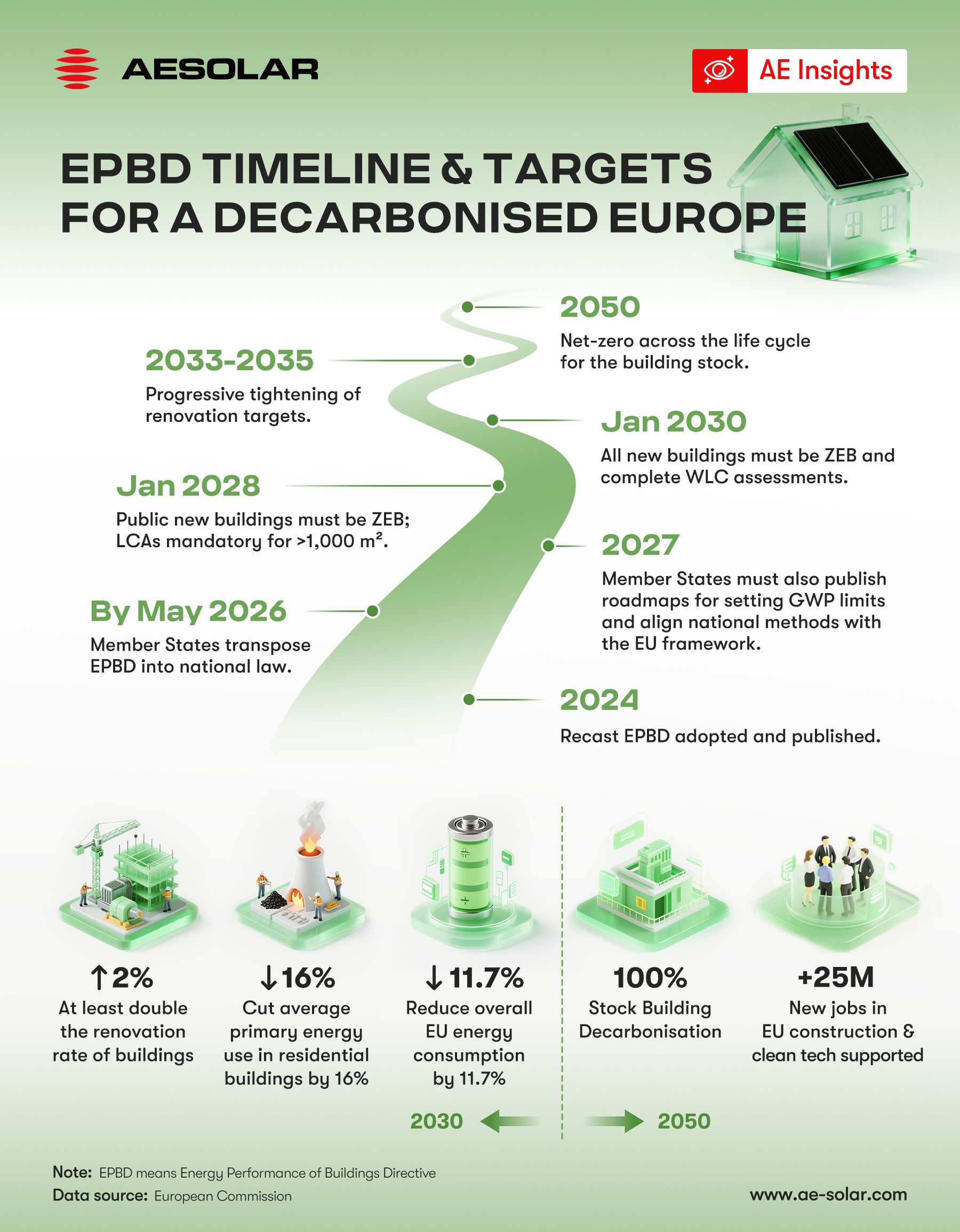
Buildings account for nearly 40% of Europe’s total energy consumption, and close to 50% of all natural gas use comes from heating and cooling buildings. Yet 85% of Europe’s buildings were built before 2000, and 75% have poor energy performance ratings. With renovation rates stuck at just 1% per year, the building sector has long been one of the EU’s biggest climate challenges.
The revised Energy Performance of Buildings Directive (EPBD) aims to change this trajectory. The new legislation—part of the European Green Deal—sets a clear pathway for a fully decarbonised building stock by 2050. Beyond energy savings, the EPBD is expected to boost the EU’s construction and clean-tech sectors, which would employ nearly 25 million people.
Major EPBD Milestones
- 2024 —— Recast EPBD adopted and published.
- 2026 —— Member States must transpose the EPBD into national law.
- 2027 —— National roadmaps for lifecycle GHG limits (GWP) must be published, aligning national methods with the EU framework.
- 2028 —— All new public buildings must be Zero-Emission Buildings (ZEB); life-cycle assessments required for buildings >1,000 m².
- 2030 —— All new residential and non-residential buildings must meet ZEB standards and complete full Whole-Life Carbon (WLC) assessments.
- 2033–2035 —— Further tightening of energy renovation targets for worst-performing buildings.
- 2050 —— Full life-cycle net-zero emissions across the building stock.
These targets illustrate the scale of Europe’s ambition. Entering 2030, the zero-emission standard remains firmly in place for all new buildings, with short-term targets including:
√ 16% reduction in average primary energy use in residential buildings by 2030.
√ 20–22% reduction by 2035.
√ Annual renovation rate doubled to at least 2%.
√ Worst-performing non-residential buildings: 16% renovated by 2030, 26% by 2033.
√ 11.7% reduction in overall EU energy consumption by 2030.
A defining feature of the EPBD recast is the requirement that all new buildings achieve zero-emission standards and be designed as “solar-ready.” In practice, this means new buildings must include the structural and electrical provisions needed for rooftop PV or solar thermal systems at the design stage, making solar a de facto standard for future construction. The directive further states that major renovation projects must prioritise the installation of renewable energy technologies, reinforcing the role of rooftop PV and building-integrated photovoltaics (BIPV) in decarbonising Europe’s buildings. Whether through new construction or renovation, solar will play an increasingly central role in how European buildings are powered.This legislative shift also opens up significant opportunities for the solar industry.

Markets such as solar carports, agrivoltaics, and building-integrated photovoltaics (BIPV) are poised to expand as buildings adopt multifunctional solar solutions that support both energy generation and structural utility. Carports are transforming parking infrastructures into decentralised power plants; agrivoltaics allow land to serve dual purposes for food and clean energy production; and BIPV enables architects to integrate PV directly into facades, skylights, and roofing elements while meeting strict WLC reporting obligations. These segments will require more specialised engineering, structural design, and installation expertise as adoption increases. AESOLAR is prepared for this shift with a portfolio designed for precisely these demands—from dedicated carport modules in the Horizon series, to Terra agrivoltaic solutions, to INVITAIC BIPV systems engineered for architectural integration. As EPBD transforms Europe’s built environment, these advanced solar solutions will play a central role in meeting both regulatory standards and market expectations.

With the comprehensive product ecosystem and growing focus on specialised solar applications, AESOLAR is committed to supporting this transformation and enabling the new generation of energy-efficient, solar-integrated European buildings. AESOLAR is committed to delivering high-efficiency modules and system solutions that support the growth of rooftop solar, carport structures, agrivoltaic applications, and BIPV projects—helping partners across Europe meet EPBD requirements and advance the transition toward a decarbonised, net-zero building sector.
Reach out to AESOLAR for your next solar project: CONTACT US
